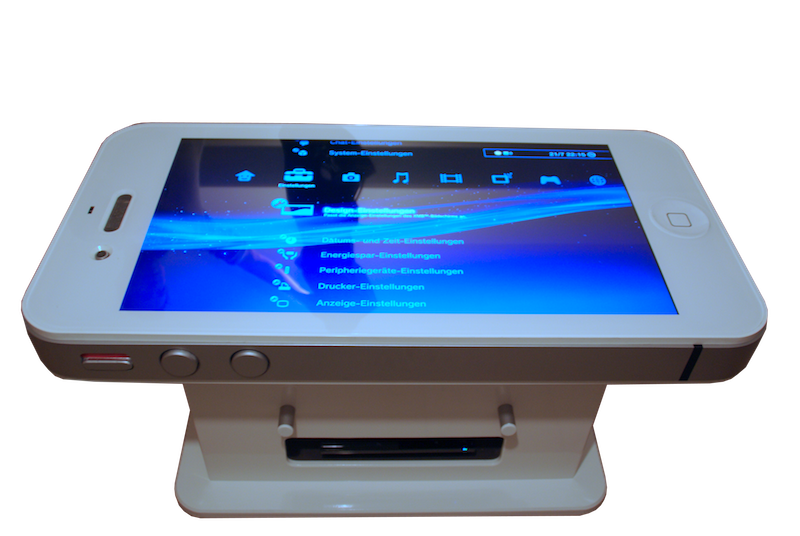HTPC Mod Looks Like Giant iPhone, Plays Crysis
Here's the ideal custom HTPC for Apple fans.
Benjamin Bachmeier has created a custom home theater PC (HTPC) that should leave Apple fans with a warm and fuzzy feeling all over. It's called the iTableous, and its main body is shaped like a giant iPhone 4, as seen in the picture to the right.
"The idea came while watching various DIY projects on the net. The idea to build an iPhone in the form of a table is not new," he said in a forum post. "The implementation has not nearly convinced me so far. This is probably because I like to expect a certain functionality of the products I use. In short, I wanted to do it better and have tinkered four months."
According to Bachmeier, the rig's 40-inch screen isn't touch capable -- instead it's actually a Toshiba LED LCD monitor. Underneath is a fanless ZOTAC ION ITX A-E clocked at 2.01 GHz, 4 GB of DDR2 RAM and a 500 GB HDD. The cooling system includes four 80-mm Revoltec "AirGuard" coolers (with Hysint bearings), four 40-mm Xilence Low-Noise coolers and a self-made fan-control to avoid high noise levels.
As for input and output functionality, the iPhone 4 mod consists of one Line-In port, one USB 2.0 port, a CD / DVD-RW Slot-In (SuperDrive), two additional HDMI input ports for connecting a PlayStation 3 and other compatible devices, and an antenna cable for DVB-T reception. There's also one eSATA port, an optical audio port, a DVI port and an Ethernet port. The rig also sports 802.11 b/g/n, Bluetooth 2.1 + EDR and more. The rig also has the ability to dual-boot into Mac OSX 10.6.7 (Hackint0sh) or Windows 7 Professional.
"Since there is no provider that offers a slide in at least 40- inches with a USB connection, I have to use a wireless keyboard to use the computer," he writes in a forum post. "As an alternative, I have a Wii Remote diverted to operate the IR-Cam over two small infrared lights with LED signals and thus to operate the computer with pseudo-multi-touch. This feature is not yet satisfying and is therefore more alpha than beta (check Wiimote Whiteboard Solution to gain an idea of what I want to do with that)."
To see a full list of specs and how Bachmeier turned the iPhone 4 buttons into functional controls, check out his PDF file right here. Additional photos can be seen here.
Get Tom's Hardware's best news and in-depth reviews, straight to your inbox.

Kevin Parrish has over a decade of experience as a writer, editor, and product tester. His work focused on computer hardware, networking equipment, smartphones, tablets, gaming consoles, and other internet-connected devices. His work has appeared in Tom's Hardware, Tom's Guide, Maximum PC, Digital Trends, Android Authority, How-To Geek, Lifewire, and others.
-
HDmac HTPC Mod Looks Like Giant iPhone, Plays CrysisReply
Here's the ideal custom HTPC for Apple fans.
See here's the thing there is a paradox in the fist two sentences. I will now point out the key words in the phrase.
Plays Crysis......for Apple fans
Paradox much? -
>CrysisReply
>Ion
So it plays Crysis at .5 fps? I think the author means that it can play Crysis if you connect a PS3 as mentioned in the article in which case any monitor can play crysis (if you connect a desktop to it of course). I call false advertising. -
damianrobertjones Shame that you have to make your mod look like an apple product to get pressReply -
aznshinobi ? Why not use a mini-itx Llano? Llano is at least better than the ION, computing/APU/All around. I mean maybe except the TDP, but even still Llano is a pretty ideal HTPC chip for now-a-days. Also... What OS is it running? It seems like the PSP/PS3 Linux OS.Reply
